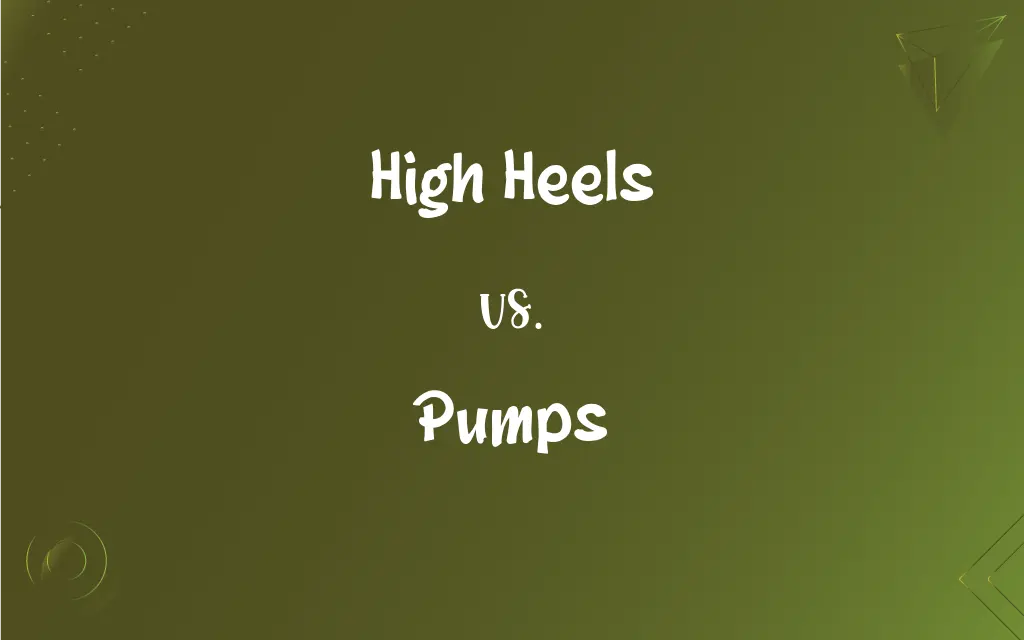High Heels vs. Pumps: What's the Difference?
Edited by Janet White || By Harlon Moss || Updated on October 10, 2023
High heels refer to shoes that elevate the heel, while pumps are specifically low-cut shoes, usually with a heel, offering a seamless, elegant appearance.

Key Differences
High heels and pumps serve as prominent symbols in fashion and style, albeit with distinct features and purposes. High heels, as a general term, embody a myriad category that refers to footwear with heels of various heights and styles, presenting an elevated heel compared to the toe. On the contrary, pumps typically denote a particular type of high heel, portraying a specific, consistent style. Pumps traditionally exhibit a low-cut front, a rounded toe, and can have a heel of any height, though they usually come with a modest or high heel.
The allure of high heels broadly spans from stilettos to kitten heels, reflecting the varying heights and shapes of the heel itself. High heels can be strappy, open-toe, closed-toe, and even extend to boots, showcasing an extensive spectrum of styles and designs that cater to diverse fashion statements and occasions. Pumps, with their distinctive silhouette, impart a classic and often formal look. They do not utilize fastenings and sport a low-cut design, commonly enveloping the foot in an uncomplicated, sleek manner.
The universality of high heels is evident in their pervasive presence across numerous social and professional settings, enhancing the wearer's height and altering posture. They’re celebrated for their ability to embellish countless styles, from the audacious to the sophisticated. On the flip side, pumps, while they fall under the high heel category when they do have elevated heels, uphold a reputation for merging grace and functionality, frequently featuring in professional and formal environments due to their understated elegance and relative comfort.
Navigating through various cultural and fashion contexts, high heels have been emblematic of femininity, empowerment, and sometimes, rebellion. They traverse the boundaries of casual wear to high fashion, adapting to variegated aesthetic narratives. Pumps, sustaining their timeless appeal, have been synonymous with subtle elegance and have historically been paired with business attire, evening wear, and are a quintessential component of any classic, chic wardrobe.
The dichotomy between high heels and pumps persists in their application and visual rhetoric. High heels, with their multiple styles and constructions, offer a diverse palette for self-expression through fashion, and pumps remain a steadfast, perennial favorite for those who seek a blend of traditional elegance and versatility in their footwear.
ADVERTISEMENT
Comparison Chart
Definition
Shoes that elevate the heel above the toe.
Low-cut, no-fastening shoes, often heeled.
Variety
Come in various styles and designs.
Specific, consistent style and design.
Usage
Suitable for casual to formal settings.
Commonly used in formal/professional wear.
Heel Type
Can have various types and heights of heels.
Typically have modest or high heels.
Toe Style
Can be open, closed, or peep toe.
Usually feature a closed, rounded toe.
ADVERTISEMENT
High Heels and Pumps Definitions
High Heels
High heels can be crafted in varied styles, such as stilettos, wedges, and platforms.
The variety of high heels in her closet ranged from sleek stilettos to casual wedges.
Pumps
Pumps can have a heel of varying height, though frequently modest or high.
Her kitten-heel pumps provided elegance without compromising comfort.
High Heels
High heels are utilized across multiple contexts, from casual outings to formal events.
High heels can elevate a casual outfit or complete an elegant evening look.
Pumps
Pumps often feature a rounded or sometimes pointed toe design.
She chose classic pointed-toe pumps to complement her evening dress.
High Heels
High heels are shoes elevating the heel significantly above the toe.
Her red high heels became the vibrant focal point of the outfit.
Pumps
Pumps often embody a streamlined, unembellished aesthetic, offering a sleek appearance.
The minimalist design of her pumps provided a subtle, chic foundation for her colorful outfit.
High Heels
High heels enhance height and can modify the wearer’s posture and gait.
Wearing high heels, she walked confidently into the room, exuding an air of authority.
Pumps
Pumps are renowned for their versatile wearability in both casual and formal settings.
She often chose pumps for their ability to transition from office wear to evening attire effortlessly.
High Heels
High heels may have various toe configurations including open, closed, or peep toe.
Her peep-toe high heels offered a playful peek at her vibrant nail polish.
Pumps
Pumps are typically low-cut, heeled footwear with no fastenings.
Her black leather pumps paired perfectly with her business suit.
Pumps
A machine or device for raising, compressing, or transferring fluids.
Pumps
(Physiology)A molecular mechanism for the active transport of ions or molecules across a cell membrane.
FAQs
How do pumps differ from other high heels?
Pumps are a specific style of shoe, typically low-cut, without fastenings, and often heeled, providing a classic appearance.
What defines high heels?
High heels are shoes that elevate the heel above the toes, offering varied styles and designs.
Do pumps only come with high heels?
No, pumps can have various heel heights, from flat to high, with the common feature being their low-cut, no-fastening design.
Can pumps be styled with jeans?
Yes, pumps can be stylishly paired with jeans, offering a smart-casual aesthetic.
What occasions are high heels suitable for?
High heels can be suitable for a range of occasions, from casual outings to formal events, depending on the style.
Are pumps suitable for formal wear?
Absolutely, pumps are often chosen for formal and professional settings due to their classic and understated elegance.
Are pumps generally more comfortable than other high heels?
Pumps are often perceived as comfortable due to their stable and classic design, but comfort can depend on individual fit and preference.
What is the typical toe design of pumps?
Pumps typically feature a closed toe, often rounded, although pointed-toe pumps are also prevalent.
What materials are high heels made from?
High heels can be made from a variety of materials, including leather, suede, fabric, and synthetics.
Are pumps made of leather?
Pumps can be made of leather but are also available in various other materials like fabric, suede, or synthetic materials.
Are pumps suitable for winter wear?
While pumps can be worn in winter, considerations like material and weather conditions (e.g., snow) might influence this choice.
Can high heels be casual?
Absolutely, high heels like wedges or low-heeled sandals can be quite casual and versatile.
Can high heels be worn in all seasons?
Yes, high heels can be worn in all seasons, with designs, materials, and styles adapting to seasonal fashion trends.
Can pumps be worn with formal dresses?
Definitely, pumps are often a popular choice to pair with formal dresses due to their elegant and classic appearance.
Are all high heels uncomfortable?
Comfort in high heels can vary based on design, fit, and heel height, and personal preference plays a significant role.
Can high heels have different toe designs?
Yes, high heels can feature various toe designs, such as open, closed, or peep toe.
Do high heels only come in one heel shape?
No, high heels can have various heel shapes, like stiletto, block, or wedge heels.
Can pumps be considered high heels?
Yes, pumps can be considered a type of high heel when they feature a raised heel.
Can men wear high heels or pumps?
Yes, men can wear high heels and pumps, as fashion is inclusive and individualistic.
Do high heels affect posture?
Yes, high heels can alter posture and gait due to the elevation of the heel.
About Author
Written by
Harlon MossHarlon is a seasoned quality moderator and accomplished content writer for Difference Wiki. An alumnus of the prestigious University of California, he earned his degree in Computer Science. Leveraging his academic background, Harlon brings a meticulous and informed perspective to his work, ensuring content accuracy and excellence.
Edited by
Janet WhiteJanet White has been an esteemed writer and blogger for Difference Wiki. Holding a Master's degree in Science and Medical Journalism from the prestigious Boston University, she has consistently demonstrated her expertise and passion for her field. When she's not immersed in her work, Janet relishes her time exercising, delving into a good book, and cherishing moments with friends and family.































































